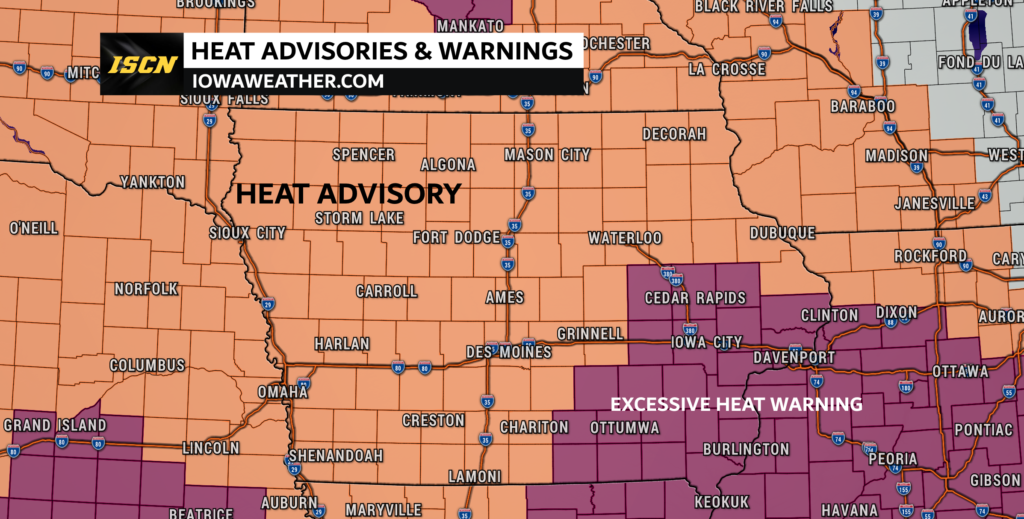
As temperatures soar and summer reaches its peak, the National Weather Service (NWS) has issued a heat advisory for a large portion of Iowa. The advisory is now in effect and will be in effect through 9 PM CDT Friday for some. Within this heat advisory area, heat index values will reach up to 110 degrees. Such extreme heat can pose serious health risks, and it is essential for everyone to take necessary precautions to protect themselves and their loved ones.
What is a Heat Advisory?
A heat advisory is a weather warning issued by the National Weather Service, to alert the public about the likelihood of excessively high temperatures and heat index values. The purpose of this advisory is to raise awareness and prompt individuals to take necessary precautions to protect themselves from the potentially hazardous impacts of extreme heat.
Heat index is a crucial factor in determining the severity of a heatwave. It takes into account not only the actual air temperature but also the level of humidity. When humidity levels are high, the body’s ability to cool itself through sweating is compromised, leading to increased discomfort and potential health risks.
When is a Heat Advisory Issued?
A Heat Advisory is typically issued by the National Weather Service when the following conditions are expected in a particular area:
- High Temperatures: The advisory is triggered when forecasted temperatures are expected to reach or exceed a specific threshold for a given region. This threshold may vary depending on the climate and usual weather patterns of the area.
- High Humidity Levels: The combination of high temperatures and elevated humidity levels results in a heat index that exceeds a predetermined value, often around 100 degrees Fahrenheit or higher.
- Duration of Extreme Heat: The duration of the expected high temperatures and heat index values is also taken into account. If oppressive heat is forecasted to persist for an extended period, the advisory may be issued for multiple days.
- Potential Impact on Health and Safety: Authorities consider the potential health risks associated with the forecasted conditions. Heat-related illnesses, such as heat exhaustion and heatstroke, become more likely as the heat index rises, especially for vulnerable populations like the elderly, young children, and individuals with pre-existing medical conditions.
- Geographical Coverage: Heat advisories are issued for specific regions or counties that are expected to experience the extreme heat conditions. The NWS takes into account the local climate and weather patterns to determine the affected areas.
Potential Impacts on Health
The scorching temperatures, coupled with high humidity, can result in adverse health effects. Heat-related illnesses, such as heat exhaustion and heatstroke, become more prevalent during such conditions. Common symptoms of heat exhaustion include heavy sweating, weakness, dizziness, headache, and nausea. If not addressed promptly, heat exhaustion can escalate to heatstroke, which is a medical emergency and requires immediate attention. Heatstroke symptoms include high body temperature, confusion, loss of consciousness, and even organ failure.
Precautionary Measures
To safeguard yourself and those around you from the heat’s harmful effects, it’s crucial to take the following precautionary measures:
- Stay Hydrated: Drink plenty of fluids, even if you don’t feel thirsty. Water, sports drinks, and electrolyte beverages can help replenish the body’s lost fluids due to sweating.
- Stay Indoors: Seek refuge in air-conditioned buildings during the hottest parts of the day. If your home lacks air conditioning, consider visiting a shopping mall, public library, or any other public facility with cooling systems.
- Avoid Direct Sun Exposure: Limit your time outdoors, especially during peak sunlight hours. If you must be outside, try to stay in shaded areas and wear wide-brimmed hats and sunglasses.
- Check on Vulnerable Individuals: Reach out to elderly family members, neighbors, and friends, as well as those with chronic health conditions, to ensure they are coping with the heat and have adequate cooling options.
- Never Leave Children or Pets in Vehicles: The inside of a parked car can quickly become a death trap in high temperatures. Never leave children or pets unattended in a vehicle, even for a short period.
- Modify Outdoor Activities: If you work or engage in outdoor activities, consider rescheduling them for the cooler hours of the day, such as early morning or evening. Take frequent breaks and rest in shaded or air-conditioned environments.
- Recognize Heat-Related Illness Symptoms: Educate yourself and others about the signs of heat exhaustion and heatstroke. If you or someone else exhibits symptoms of heatstroke, call emergency services immediately (dial 911).
As the heat advisory takes effect from noon Wednesday, it’s vital for residents in the affected regions to be vigilant and take necessary precautions. Extreme heat can be life-threatening, but by following the advice of the National Weather Service and taking preventive measures, we can safeguard ourselves and our communities from the scorching temperatures. Stay cool, stay hydrated, and look out for one another during this hot spell. Together, we can beat the heat and ensure a safe summer for everyone.
To check the latest heat index for your current location, be sure to download our free ISCN Weather app!